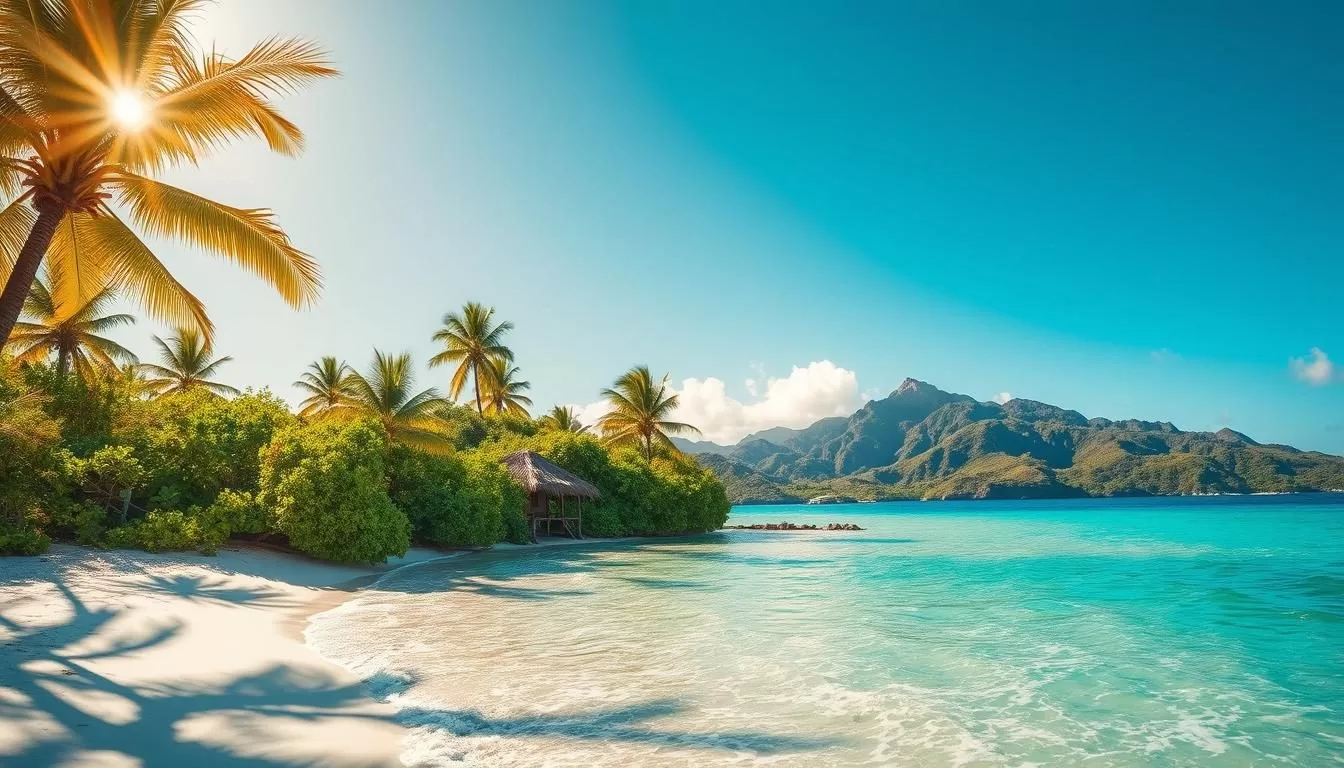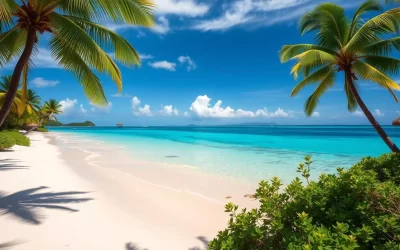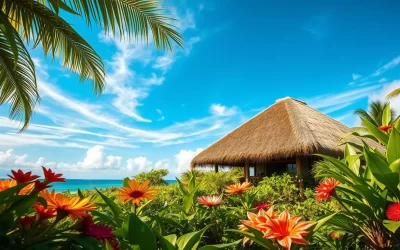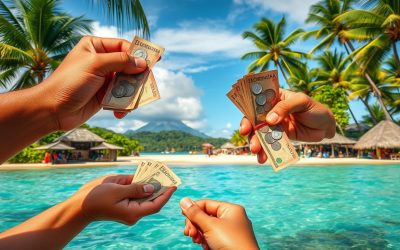✓ Accommodations✓ Flights✓ Rental Cars✓ Tours & Activities
Planning a trip to Micronesia requires careful consideration of the weather. The climate in this tropical paradise is characterized as hot, oppressive, windy, and overcast, with temperatures ranging from 78°F to 87°F throughout the year.
Understanding the unique climate and weather patterns is crucial to making the most of your trip. The archipelago’s vast geography, spanning over 2,000 miles of ocean, creates diverse weather conditions across different island groups.
By learning about the factors that determine the best time to visit, you’ll be able to plan your travel accordingly and enjoy the islands’ world-class diving sites and rich cultural heritage.
Understanding Micronesia’s Tropical Climate
As you plan your trip to Micronesia, it’s essential to grasp the nuances of its tropical climate. Micronesia’s weather is characterized by relatively stable temperatures throughout the year, but the region experiences two distinct seasons that significantly impact the travel experience.
Year-Round Temperature Patterns
Micronesia’s tropical climate means that temperatures remain relatively consistent throughout the year. The average temperature ranges from 77°F to 86°F (25°C to 30°C), making it an ideal destination for travelers seeking warm weather. The temperature variations are more pronounced between day and night rather than between seasons.
The Two Major Seasons
Micronesia has two major seasons: a drier season from December to April and a wetter season from May to November. The wetter season, which lasts approximately 6.7 months (from May 2 to November 23), is characterized by a greater than 62% chance of a given day being a wet day. Conversely, the drier season spans about 5.3 months, from November 23 to May 2.
The transition between these seasons is gradual, with May and November serving as shoulder months when weather patterns begin to shift. During the drier season, stronger northeast trade winds provide relief from humidity, making the weather more comfortable for outdoor activities.
| Season | Duration | Characteristics |
|---|---|---|
| Drier Season | December to April (5.3 months) | Less rainfall, stronger northeast trade winds |
| Wetter Season | May to November (6.7 months) | Higher chance of wet days, increased rainfall |
Understanding these seasonal patterns is crucial for aligning your travel plans with your preferred weather conditions and planned activities. The rainfall distribution varies not just seasonally but also geographically across different island groups, making it essential to research the specific weather patterns for your destinations within Micronesia.
Micronesia: Best Months for a Weather-Savvy Trip
If you’re considering a trip to Micronesia, knowing the peak travel months can make all the difference. The region’s tropical climate means that it’s a year-round destination, but certain periods stand out for their favorable weather conditions.
January to May: The Drier Season
The period from January to May is characterized by drier weather, making it an ideal time for outdoor activities and exploring the islands. During these months, you’re likely to experience clear, rainless days with comfortable temperatures, perfect for enjoying Micronesia’s renowned beaches and underwater attractions.
- The tourism score, which favors clear days with temperatures between 65°F and 80°F, peaks in the second week of February, indicating it’s one of the best times for general outdoor activities.
- The beach/pool score, favoring temperatures between 75°F and 90°F, also reaches its peak in the first week of February, making late December to mid-April ideal for hot-weather activities.
Peak Travel Periods and Why
Peak travel periods in Micronesia, particularly February and March, offer the optimal combination of dry weather, comfortable temperatures, and good visibility. These months coincide with winter in the Northern Hemisphere, making Micronesia an attractive warm-weather escape for many travelers. Even during the peak season, many of Micronesia’s islands remain less crowded compared to more mainstream Pacific destinations.
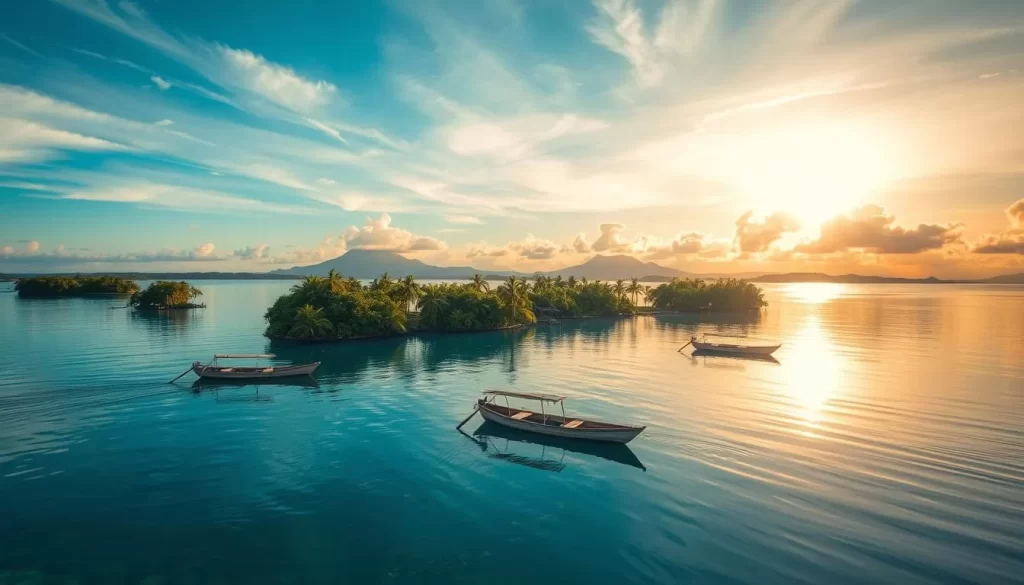
Understanding these patterns can help you plan your trip, including booking accommodations and planning activities, ensuring a more enjoyable and stress-free experience in Micronesia.
Weather Breakdown by Season
Micronesia’s tropical climate means that the weather is generally warm, but there are distinct wet and dry seasons to be aware of. Understanding these seasonal patterns is crucial for planning your trip.
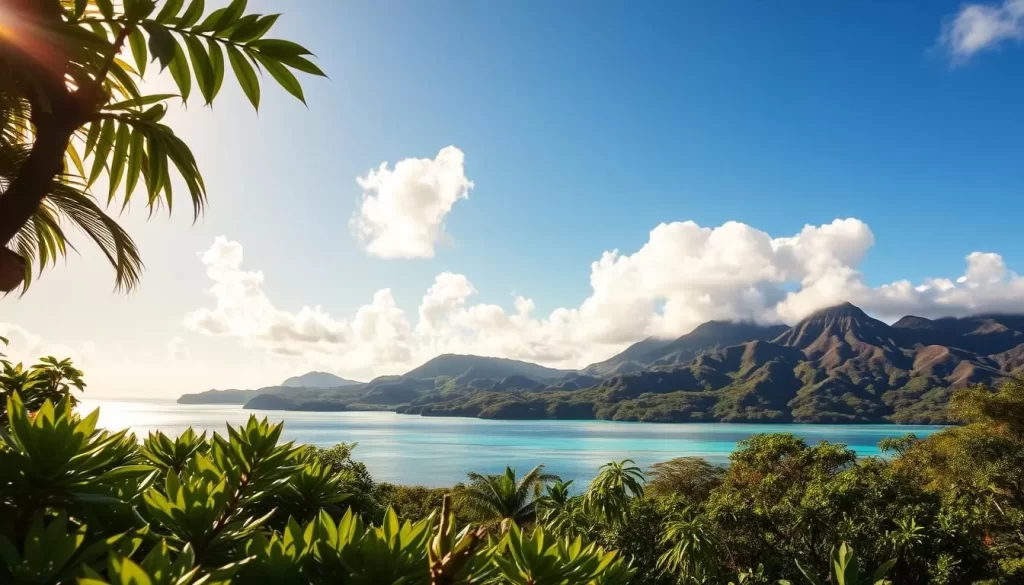
December to April: Optimal Weather Conditions
During this time, Micronesia experiences its dry season, with minimal rainfall and plenty of sunshine. The weather is ideal for outdoor activities like diving, hiking, and exploring the islands. With comfortable temperatures and low humidity, December to April is considered the best period to visit Micronesia.
May to August: Increasing Rainfall
As the dry season comes to an end, May to August sees an increase in rainfall across various areas of Micronesia. While the rain showers can be intense, they are often followed by sunshine, and the lush vegetation is particularly vibrant during this period. Visitors should be prepared for occasional rain and potential disruptions to outdoor activities.
September to November: Typhoon Season Considerations
Micronesia’s location at the southern edge of the typhoon belt means that the islands are relatively less prone to direct hits. However, September to November is still considered typhoon season, and visitors should be aware of the potential risks. By staying informed about weather forecasts and taking necessary precautions, you can minimize the impact of typhoons on your travel plans.
Island-Specific Weather Patterns
Each island in Micronesia boasts its own microclimate, shaping the travel experience. As you journey through this Pacific archipelago, understanding these variations will help you make the most of your trip.
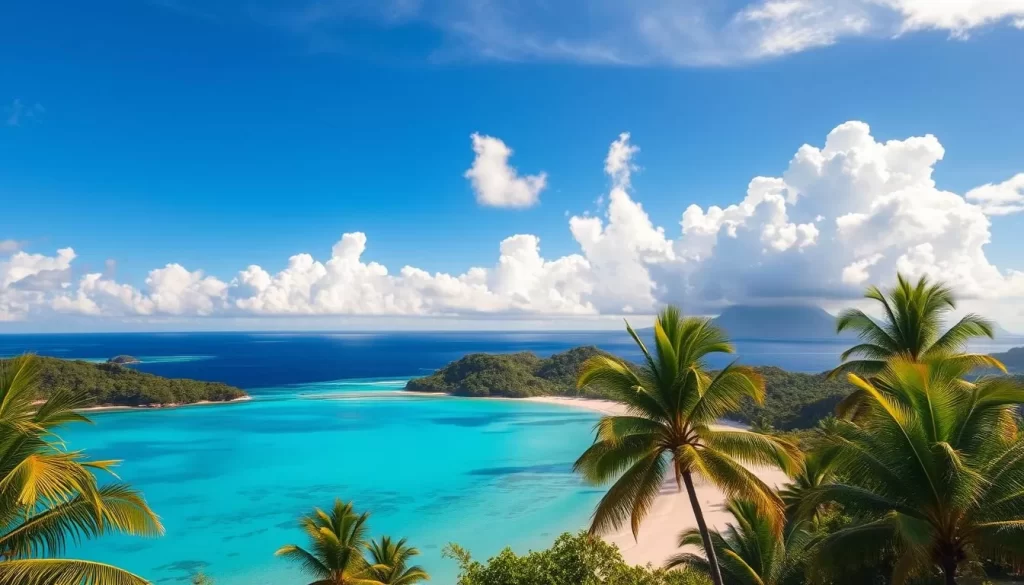
Chuuk: Diving Conditions Throughout the Year
Chuuk is renowned for its exceptional diving opportunities. The diving conditions remain favorable throughout the year, with visibility often exceeding 30 meters. You can plan your diving adventures regardless of the season, exploring the island’s rich marine life and historic wrecks.
Kosrae: Best Hiking Months
If you’re an avid hiker, Kosrae is a paradise. The best months for hiking are from January to April, when the weather is drier and trails are less slippery. This period allows for a more enjoyable and safer hiking experience, as you explore the island’s lush forests and scenic landscapes.
Pohnpei: Navigating the Rainiest Island
Pohnpei is known as the rainiest island in Micronesia. To navigate this island effectively, plan your outdoor activities during the morning hours when the weather is typically clearer. Embracing the island’s lush vegetation and waterfalls is a must, even on rainy days, as the rain adds to the island’s mystique.
Yap: Traditional Experiences and Weather
Yap is a cultural gem, preserving centuries-old traditions. You can experience the island’s rich culture by visiting stone money sites and participating in village visits, activities that can be enjoyed year-round. The island’s unique cultural practices and history make it a fascinating destination, regardless of the weather.
Yap’s position as Micronesia’s westernmost state influences its climate, making it somewhat more predictable for weather-dependent activities. You can enjoy diving with manta rays, playing with dolphins, or taking a traditional canoe trip, immersing yourself in the island’s culture and natural beauty.
Planning Activities Around Micronesian Weather
As you prepare for your journey to Micronesia, knowing how to plan activities according to the weather will enhance your trip. Micronesia’s climate varies significantly across its islands, impacting the suitability of various activities throughout the year.
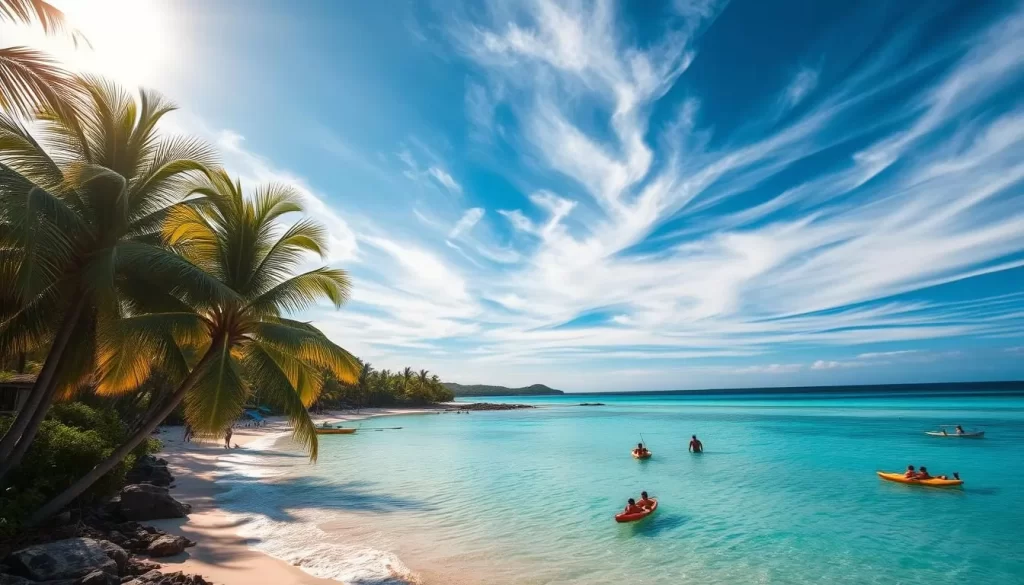
Water-Based Activities: Optimal Timing
For water-based activities like diving and canoeing, the calmer seas during the drier months (January to April) are ideal. The reduced risk of typhoons and storms during this period makes it perfect for exploring Micronesia’s renowned marine life and coral reefs.
Cultural Experiences: Weather Considerations
Cultural experiences in Micronesia, such as traditional dances and local festivals, can be enjoyed year-round. However, the cooler wind during the drier months can make outdoor events more comfortable for visitors.
Hiking and Land Exploration: Best Conditions
The drier months from January through April provide the most comfortable and safe conditions for peak hiking and land exploration in Micronesia. During this time, the trails are less slippery, and the cooling trade wind makes the tropical temperatures more bearable, enhancing your overall travel experience.
Understanding and planning around Micronesia’s weather will ensure that your activities are both enjoyable and safe, making the most of your trip.
What to Pack for Different Seasons
When planning your trip to Micronesia, it’s crucial to pack according to the season. The Pacific Islands’ diverse climate means that your luggage should be tailored to the time of your visit, ensuring a comfortable and enjoyable experience in this beautiful location.
Dry Season Essentials
During the dry season, typically from January to May, you’ll want to pack lightweight cotton clothing that allows for good airflow and comfort in the tropical climate. Quick-dry shirts and shorts are ideal for daytime activities, while a light sweater or jacket may be necessary for cooler evenings or when exploring the more mountainous inland areas.
Visitors should also consider packing:
- Comfortable walking shoes or sandals
- Sunscreen and a hat for sun protection
- Insect repellent to prevent bug bites
Wet Season Must-Haves
The wet season, which runs from May to November, requires a different packing strategy. A durable, waterproof jacket is essential to keep you dry during sudden rain showers. Additionally, consider packing quick-dry clothing, extra footwear, and waterproof bags to protect your electronics.
| Item | Description | Importance |
|---|---|---|
| Waterproof Jacket | Durable and waterproof outerwear | High |
| Quick-dry Clothing | Clothing that dries fast | Medium |
| Waterproof Bags | Bags to protect electronics | High |
| Anti-fungal Powders | For moisture control and comfort | Medium |
Weather-Savvy Travel Tips for Micronesia
A weather-savvy traveler can navigate Micronesia’s tropical climate with ease and confidence. To make the most of your trip, it’s essential to be aware of the local weather patterns and take necessary precautions.
Monitoring Weather Forecasts
Staying informed about the latest weather forecasts is crucial when traveling to Micronesia. You can monitor typhoon forecasts using reliable sources like the Joint Typhoon Warning Center or Japan Meteorological Agency. This will help you assess the actual risk and plan your activities accordingly. By being aware of the weather forecast, you can make the most of your travel experience in Micronesia.
Dealing with Humidity Year-Round
Micronesia’s tropical climate means that humidity is a constant factor throughout the year. To deal with this, pack light, breathable clothing and stay hydrated by drinking plenty of water. Be prepared for the possibility of rain showers, even during the drier season. By taking these precautions, you can enjoy your time in Micronesia without being uncomfortable.
Typhoon Preparedness
While typhoons are relatively rare in Micronesia due to its location on the southern edge of the typhoon belt, it’s still essential to be prepared. Understand that the world is experiencing changing weather patterns, and being informed can help you navigate any potential disruptions. Make sure your travel insurance covers weather-related disruptions, and stay informed about local weather conditions. By being prepared, you can minimize the impact of any weather-related issues on your Micronesia trip.
Conclusion
Micronesia’s islands beckon with their natural beauty, and timing your visit right ensures you make the most of your trip. The optimal travel window is from January through May, offering the best weather conditions for your travel plans. Each island group has distinct characteristics that might influence your choice of destinations within Micronesia. While weather is a crucial factor, the islands‘ natural beauty and cultural richness make them a rewarding destination year-round. Being flexible and having a positive attitude are key when traveling in a tropical environment where weather can change quickly. By working with rather than against Micronesia’s weather patterns, you can create an unforgettable travel experience. This ensures you’re well-prepared for your journey to the city or islands you’ve chosen, making your visit to Micronesia truly special during the best time to visit.
The above is subject to change.
Check back often to TRAVEL.COM for the latest travel tips and deals.
